All Seasons: Comprehensive Analysis of Contemporary Organisations
VerifiedAdded on 2022/11/16
|10
|2278
|167
Essay
AI Summary
This essay provides an in-depth analysis of All Seasons, a knitwear manufacturing company operating in Australia since 1962. The essay investigates the company's resources, including human, financial, physical, and technological aspects, and their management across various departments. It explores the roles of the marketing, production, HR, and finance departments, highlighting their responsibilities and interdependencies. The essay emphasizes the importance of supplier relationships, quality control, sustainable business practices, and employee management. The organizational structure, including the VRIO analysis of resources, is also discussed, revealing how All Seasons aims to maintain its competitive edge and ensure business sustainability through effective resource allocation and departmental coordination. The essay references several research papers to support its arguments and provides an overview of the company's operational strategies.
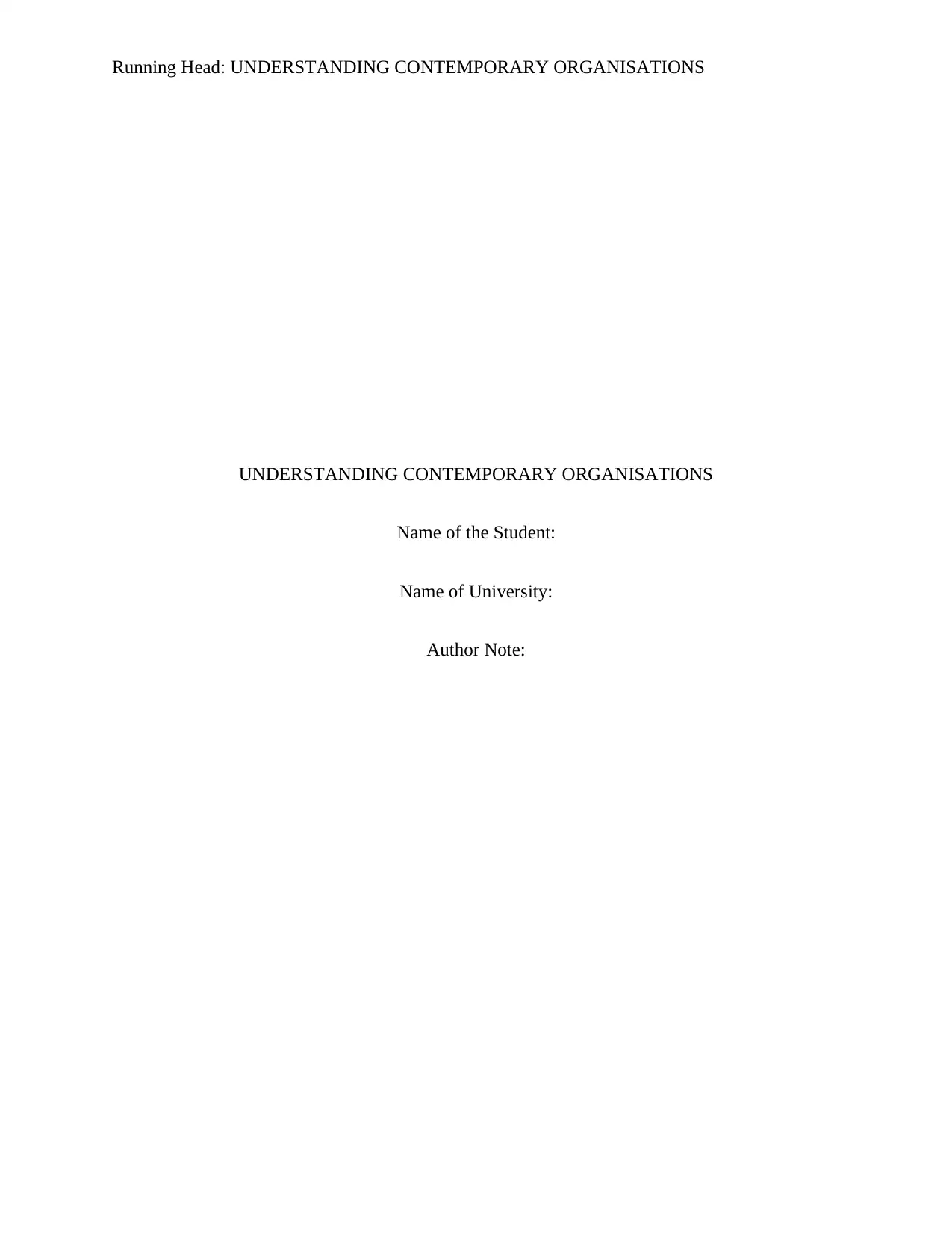
Running Head: UNDERSTANDING CONTEMPORARY ORGANISATIONS
UNDERSTANDING CONTEMPORARY ORGANISATIONS
Name of the Student:
Name of University:
Author Note:
UNDERSTANDING CONTEMPORARY ORGANISATIONS
Name of the Student:
Name of University:
Author Note:
Paraphrase This Document
Need a fresh take? Get an instant paraphrase of this document with our AI Paraphraser
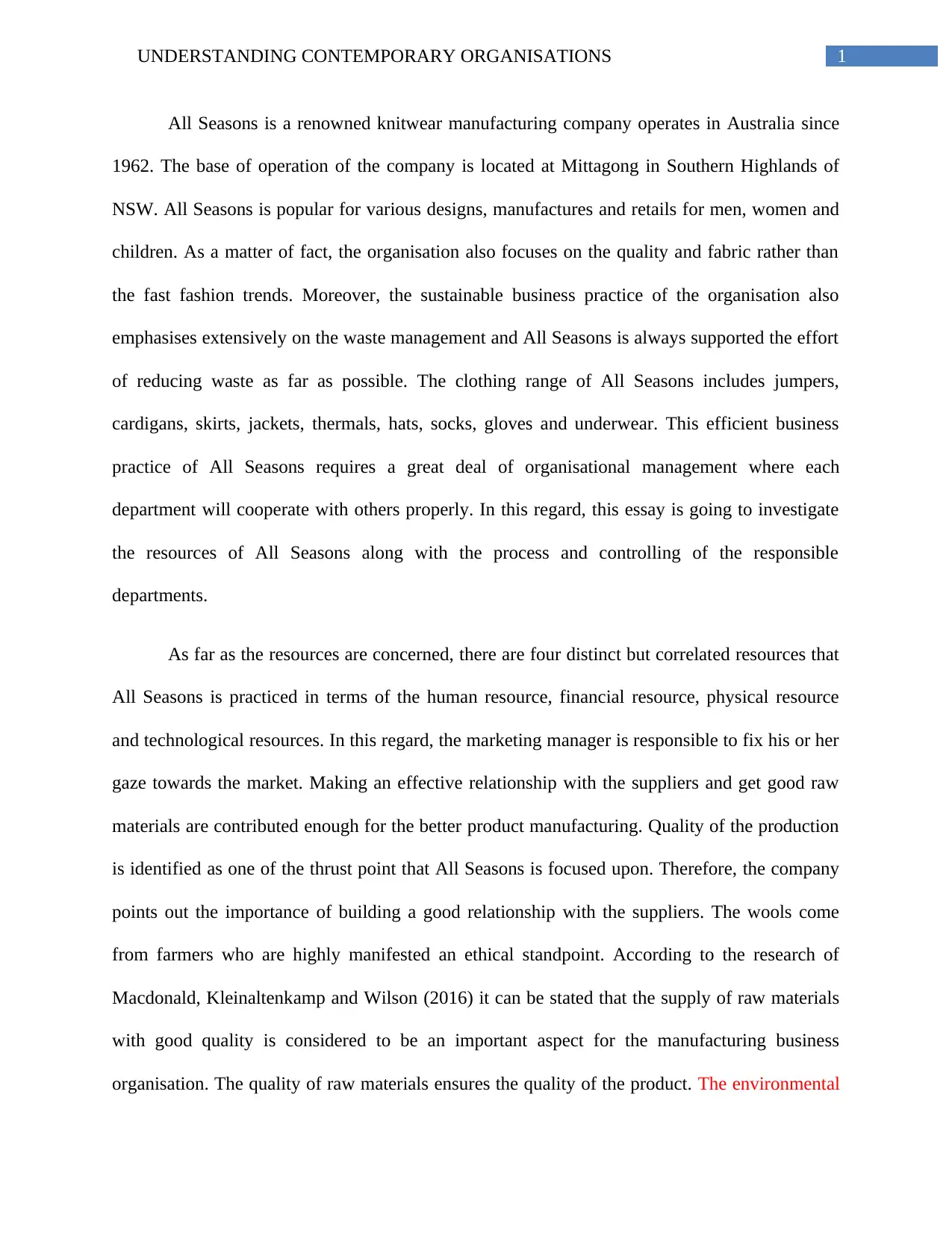
1UNDERSTANDING CONTEMPORARY ORGANISATIONS
All Seasons is a renowned knitwear manufacturing company operates in Australia since
1962. The base of operation of the company is located at Mittagong in Southern Highlands of
NSW. All Seasons is popular for various designs, manufactures and retails for men, women and
children. As a matter of fact, the organisation also focuses on the quality and fabric rather than
the fast fashion trends. Moreover, the sustainable business practice of the organisation also
emphasises extensively on the waste management and All Seasons is always supported the effort
of reducing waste as far as possible. The clothing range of All Seasons includes jumpers,
cardigans, skirts, jackets, thermals, hats, socks, gloves and underwear. This efficient business
practice of All Seasons requires a great deal of organisational management where each
department will cooperate with others properly. In this regard, this essay is going to investigate
the resources of All Seasons along with the process and controlling of the responsible
departments.
As far as the resources are concerned, there are four distinct but correlated resources that
All Seasons is practiced in terms of the human resource, financial resource, physical resource
and technological resources. In this regard, the marketing manager is responsible to fix his or her
gaze towards the market. Making an effective relationship with the suppliers and get good raw
materials are contributed enough for the better product manufacturing. Quality of the production
is identified as one of the thrust point that All Seasons is focused upon. Therefore, the company
points out the importance of building a good relationship with the suppliers. The wools come
from farmers who are highly manifested an ethical standpoint. According to the research of
Macdonald, Kleinaltenkamp and Wilson (2016) it can be stated that the supply of raw materials
with good quality is considered to be an important aspect for the manufacturing business
organisation. The quality of raw materials ensures the quality of the product. The environmental
All Seasons is a renowned knitwear manufacturing company operates in Australia since
1962. The base of operation of the company is located at Mittagong in Southern Highlands of
NSW. All Seasons is popular for various designs, manufactures and retails for men, women and
children. As a matter of fact, the organisation also focuses on the quality and fabric rather than
the fast fashion trends. Moreover, the sustainable business practice of the organisation also
emphasises extensively on the waste management and All Seasons is always supported the effort
of reducing waste as far as possible. The clothing range of All Seasons includes jumpers,
cardigans, skirts, jackets, thermals, hats, socks, gloves and underwear. This efficient business
practice of All Seasons requires a great deal of organisational management where each
department will cooperate with others properly. In this regard, this essay is going to investigate
the resources of All Seasons along with the process and controlling of the responsible
departments.
As far as the resources are concerned, there are four distinct but correlated resources that
All Seasons is practiced in terms of the human resource, financial resource, physical resource
and technological resources. In this regard, the marketing manager is responsible to fix his or her
gaze towards the market. Making an effective relationship with the suppliers and get good raw
materials are contributed enough for the better product manufacturing. Quality of the production
is identified as one of the thrust point that All Seasons is focused upon. Therefore, the company
points out the importance of building a good relationship with the suppliers. The wools come
from farmers who are highly manifested an ethical standpoint. According to the research of
Macdonald, Kleinaltenkamp and Wilson (2016) it can be stated that the supply of raw materials
with good quality is considered to be an important aspect for the manufacturing business
organisation. The quality of raw materials ensures the quality of the product. The environmental
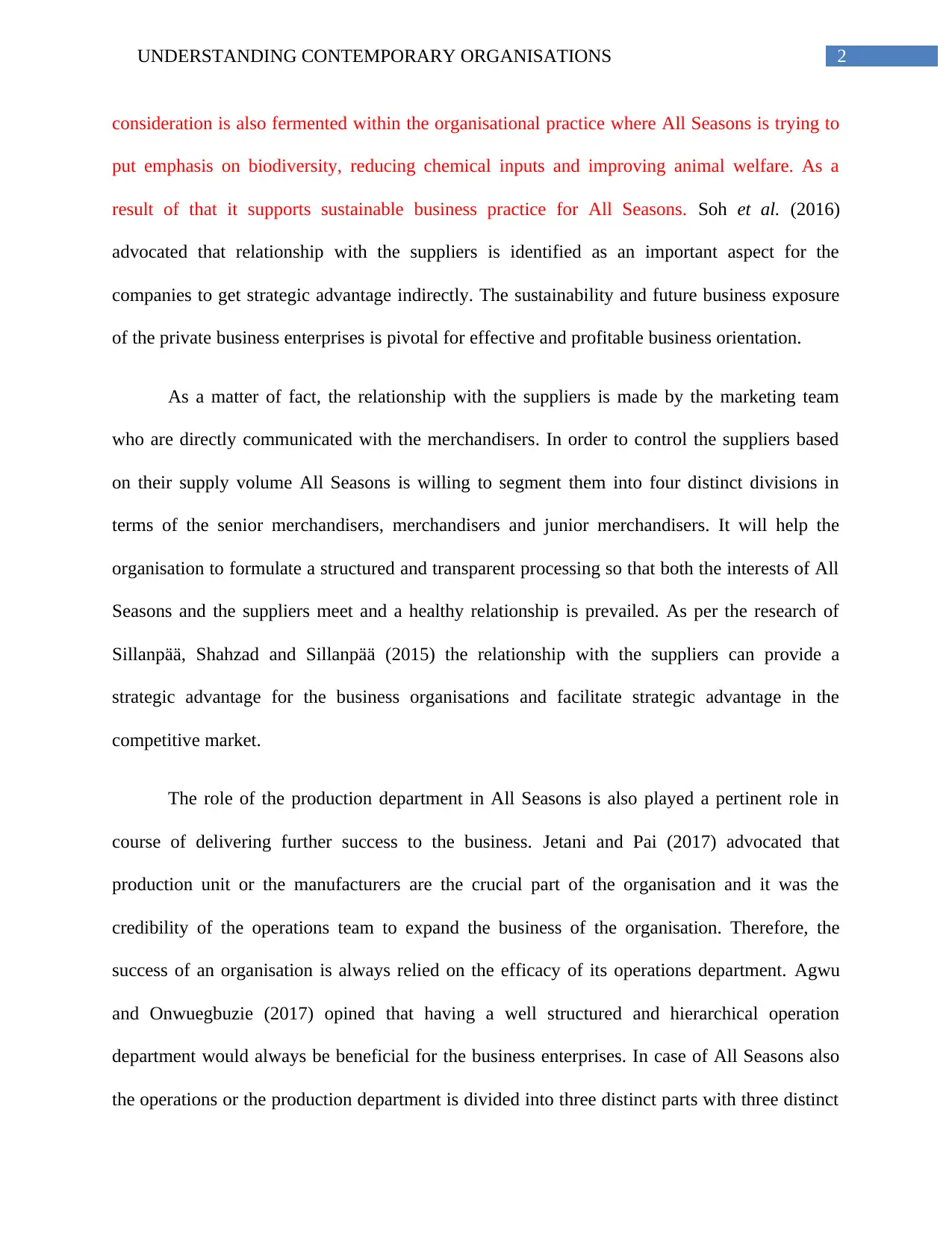
2UNDERSTANDING CONTEMPORARY ORGANISATIONS
consideration is also fermented within the organisational practice where All Seasons is trying to
put emphasis on biodiversity, reducing chemical inputs and improving animal welfare. As a
result of that it supports sustainable business practice for All Seasons. Soh et al. (2016)
advocated that relationship with the suppliers is identified as an important aspect for the
companies to get strategic advantage indirectly. The sustainability and future business exposure
of the private business enterprises is pivotal for effective and profitable business orientation.
As a matter of fact, the relationship with the suppliers is made by the marketing team
who are directly communicated with the merchandisers. In order to control the suppliers based
on their supply volume All Seasons is willing to segment them into four distinct divisions in
terms of the senior merchandisers, merchandisers and junior merchandisers. It will help the
organisation to formulate a structured and transparent processing so that both the interests of All
Seasons and the suppliers meet and a healthy relationship is prevailed. As per the research of
Sillanpää, Shahzad and Sillanpää (2015) the relationship with the suppliers can provide a
strategic advantage for the business organisations and facilitate strategic advantage in the
competitive market.
The role of the production department in All Seasons is also played a pertinent role in
course of delivering further success to the business. Jetani and Pai (2017) advocated that
production unit or the manufacturers are the crucial part of the organisation and it was the
credibility of the operations team to expand the business of the organisation. Therefore, the
success of an organisation is always relied on the efficacy of its operations department. Agwu
and Onwuegbuzie (2017) opined that having a well structured and hierarchical operation
department would always be beneficial for the business enterprises. In case of All Seasons also
the operations or the production department is divided into three distinct parts with three distinct
consideration is also fermented within the organisational practice where All Seasons is trying to
put emphasis on biodiversity, reducing chemical inputs and improving animal welfare. As a
result of that it supports sustainable business practice for All Seasons. Soh et al. (2016)
advocated that relationship with the suppliers is identified as an important aspect for the
companies to get strategic advantage indirectly. The sustainability and future business exposure
of the private business enterprises is pivotal for effective and profitable business orientation.
As a matter of fact, the relationship with the suppliers is made by the marketing team
who are directly communicated with the merchandisers. In order to control the suppliers based
on their supply volume All Seasons is willing to segment them into four distinct divisions in
terms of the senior merchandisers, merchandisers and junior merchandisers. It will help the
organisation to formulate a structured and transparent processing so that both the interests of All
Seasons and the suppliers meet and a healthy relationship is prevailed. As per the research of
Sillanpää, Shahzad and Sillanpää (2015) the relationship with the suppliers can provide a
strategic advantage for the business organisations and facilitate strategic advantage in the
competitive market.
The role of the production department in All Seasons is also played a pertinent role in
course of delivering further success to the business. Jetani and Pai (2017) advocated that
production unit or the manufacturers are the crucial part of the organisation and it was the
credibility of the operations team to expand the business of the organisation. Therefore, the
success of an organisation is always relied on the efficacy of its operations department. Agwu
and Onwuegbuzie (2017) opined that having a well structured and hierarchical operation
department would always be beneficial for the business enterprises. In case of All Seasons also
the operations or the production department is divided into three distinct parts with three distinct
⊘ This is a preview!⊘
Do you want full access?
Subscribe today to unlock all pages.

Trusted by 1+ million students worldwide
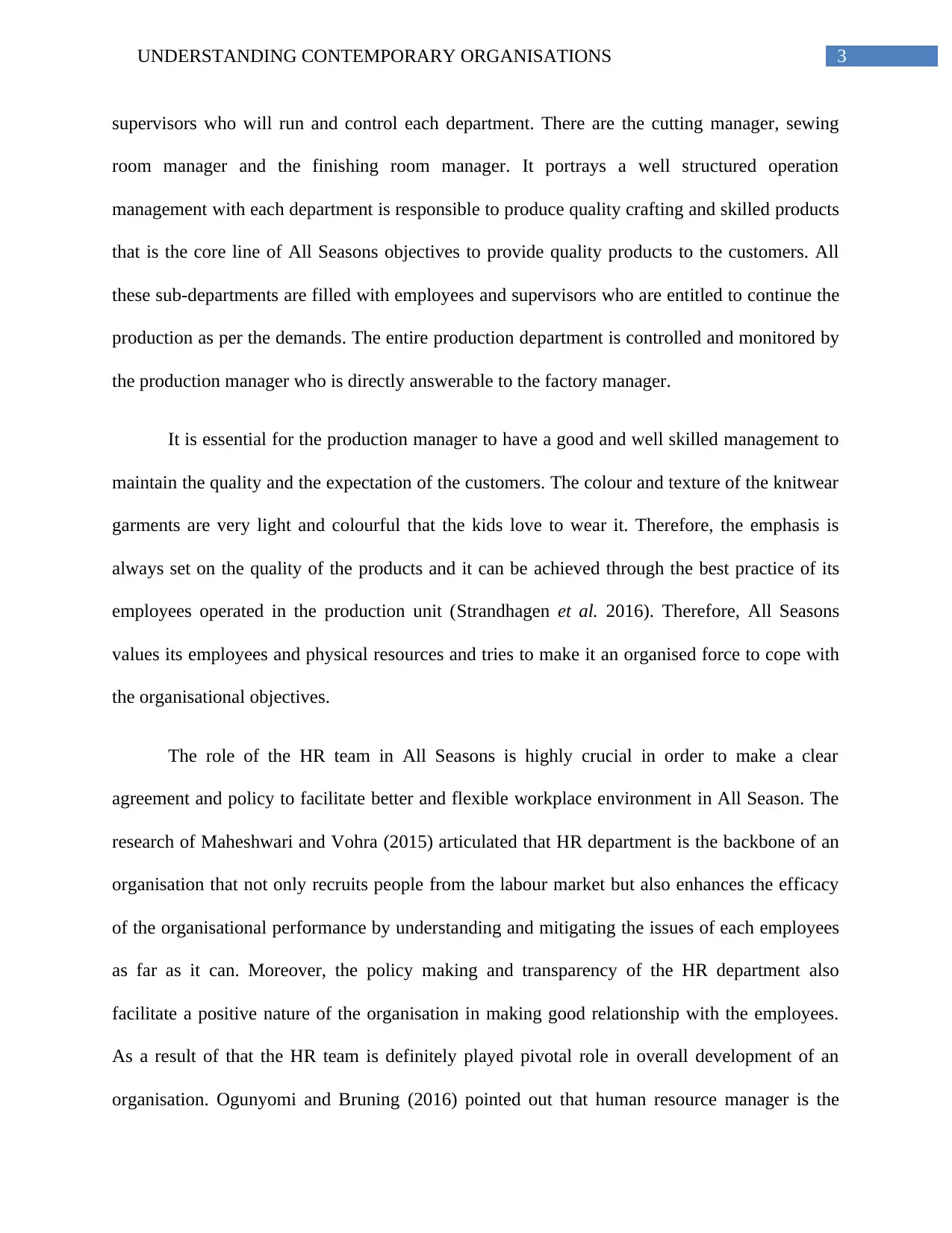
3UNDERSTANDING CONTEMPORARY ORGANISATIONS
supervisors who will run and control each department. There are the cutting manager, sewing
room manager and the finishing room manager. It portrays a well structured operation
management with each department is responsible to produce quality crafting and skilled products
that is the core line of All Seasons objectives to provide quality products to the customers. All
these sub-departments are filled with employees and supervisors who are entitled to continue the
production as per the demands. The entire production department is controlled and monitored by
the production manager who is directly answerable to the factory manager.
It is essential for the production manager to have a good and well skilled management to
maintain the quality and the expectation of the customers. The colour and texture of the knitwear
garments are very light and colourful that the kids love to wear it. Therefore, the emphasis is
always set on the quality of the products and it can be achieved through the best practice of its
employees operated in the production unit (Strandhagen et al. 2016). Therefore, All Seasons
values its employees and physical resources and tries to make it an organised force to cope with
the organisational objectives.
The role of the HR team in All Seasons is highly crucial in order to make a clear
agreement and policy to facilitate better and flexible workplace environment in All Season. The
research of Maheshwari and Vohra (2015) articulated that HR department is the backbone of an
organisation that not only recruits people from the labour market but also enhances the efficacy
of the organisational performance by understanding and mitigating the issues of each employees
as far as it can. Moreover, the policy making and transparency of the HR department also
facilitate a positive nature of the organisation in making good relationship with the employees.
As a result of that the HR team is definitely played pivotal role in overall development of an
organisation. Ogunyomi and Bruning (2016) pointed out that human resource manager is the
supervisors who will run and control each department. There are the cutting manager, sewing
room manager and the finishing room manager. It portrays a well structured operation
management with each department is responsible to produce quality crafting and skilled products
that is the core line of All Seasons objectives to provide quality products to the customers. All
these sub-departments are filled with employees and supervisors who are entitled to continue the
production as per the demands. The entire production department is controlled and monitored by
the production manager who is directly answerable to the factory manager.
It is essential for the production manager to have a good and well skilled management to
maintain the quality and the expectation of the customers. The colour and texture of the knitwear
garments are very light and colourful that the kids love to wear it. Therefore, the emphasis is
always set on the quality of the products and it can be achieved through the best practice of its
employees operated in the production unit (Strandhagen et al. 2016). Therefore, All Seasons
values its employees and physical resources and tries to make it an organised force to cope with
the organisational objectives.
The role of the HR team in All Seasons is highly crucial in order to make a clear
agreement and policy to facilitate better and flexible workplace environment in All Season. The
research of Maheshwari and Vohra (2015) articulated that HR department is the backbone of an
organisation that not only recruits people from the labour market but also enhances the efficacy
of the organisational performance by understanding and mitigating the issues of each employees
as far as it can. Moreover, the policy making and transparency of the HR department also
facilitate a positive nature of the organisation in making good relationship with the employees.
As a result of that the HR team is definitely played pivotal role in overall development of an
organisation. Ogunyomi and Bruning (2016) pointed out that human resource manager is the
Paraphrase This Document
Need a fresh take? Get an instant paraphrase of this document with our AI Paraphraser
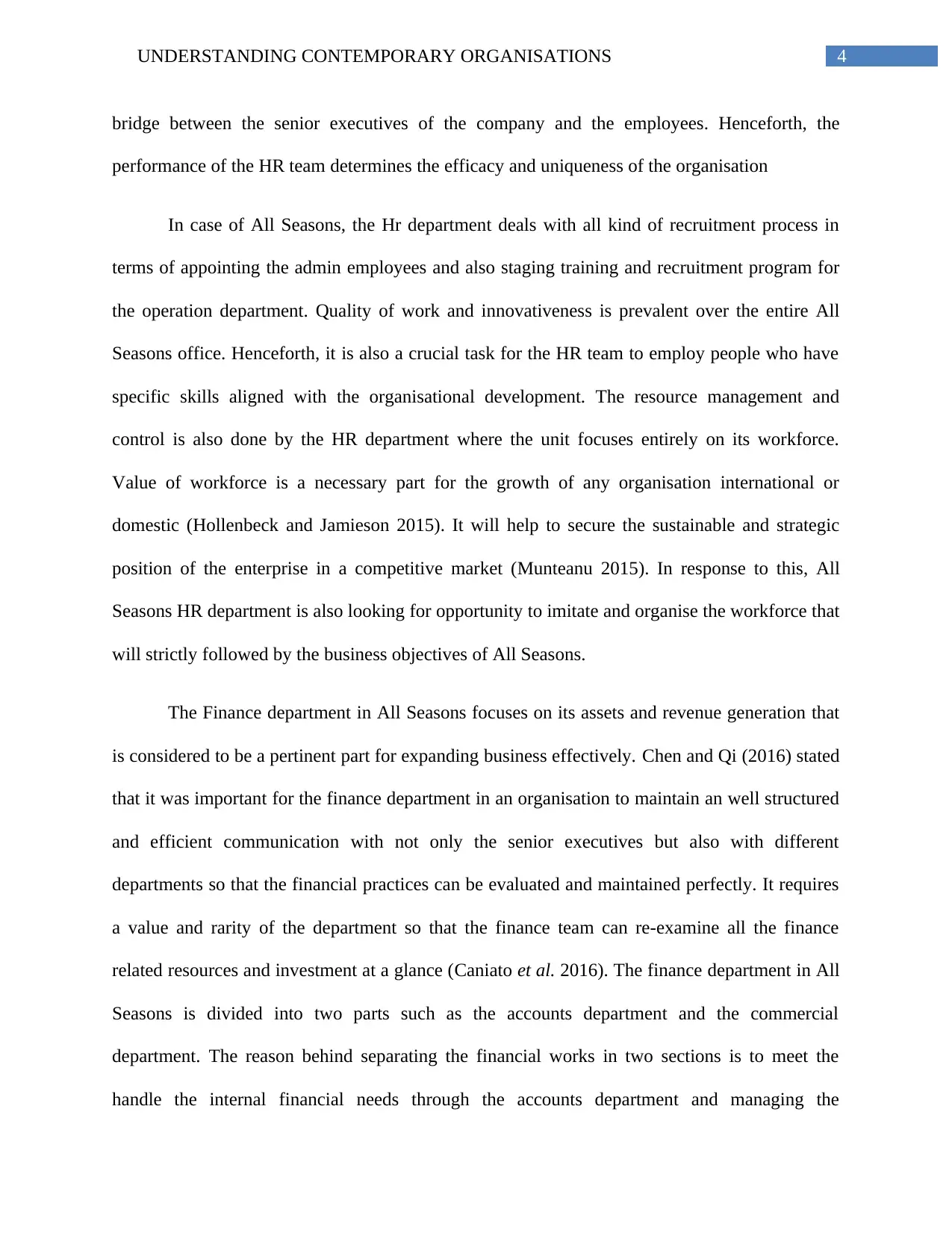
4UNDERSTANDING CONTEMPORARY ORGANISATIONS
bridge between the senior executives of the company and the employees. Henceforth, the
performance of the HR team determines the efficacy and uniqueness of the organisation
In case of All Seasons, the Hr department deals with all kind of recruitment process in
terms of appointing the admin employees and also staging training and recruitment program for
the operation department. Quality of work and innovativeness is prevalent over the entire All
Seasons office. Henceforth, it is also a crucial task for the HR team to employ people who have
specific skills aligned with the organisational development. The resource management and
control is also done by the HR department where the unit focuses entirely on its workforce.
Value of workforce is a necessary part for the growth of any organisation international or
domestic (Hollenbeck and Jamieson 2015). It will help to secure the sustainable and strategic
position of the enterprise in a competitive market (Munteanu 2015). In response to this, All
Seasons HR department is also looking for opportunity to imitate and organise the workforce that
will strictly followed by the business objectives of All Seasons.
The Finance department in All Seasons focuses on its assets and revenue generation that
is considered to be a pertinent part for expanding business effectively. Chen and Qi (2016) stated
that it was important for the finance department in an organisation to maintain an well structured
and efficient communication with not only the senior executives but also with different
departments so that the financial practices can be evaluated and maintained perfectly. It requires
a value and rarity of the department so that the finance team can re-examine all the finance
related resources and investment at a glance (Caniato et al. 2016). The finance department in All
Seasons is divided into two parts such as the accounts department and the commercial
department. The reason behind separating the financial works in two sections is to meet the
handle the internal financial needs through the accounts department and managing the
bridge between the senior executives of the company and the employees. Henceforth, the
performance of the HR team determines the efficacy and uniqueness of the organisation
In case of All Seasons, the Hr department deals with all kind of recruitment process in
terms of appointing the admin employees and also staging training and recruitment program for
the operation department. Quality of work and innovativeness is prevalent over the entire All
Seasons office. Henceforth, it is also a crucial task for the HR team to employ people who have
specific skills aligned with the organisational development. The resource management and
control is also done by the HR department where the unit focuses entirely on its workforce.
Value of workforce is a necessary part for the growth of any organisation international or
domestic (Hollenbeck and Jamieson 2015). It will help to secure the sustainable and strategic
position of the enterprise in a competitive market (Munteanu 2015). In response to this, All
Seasons HR department is also looking for opportunity to imitate and organise the workforce that
will strictly followed by the business objectives of All Seasons.
The Finance department in All Seasons focuses on its assets and revenue generation that
is considered to be a pertinent part for expanding business effectively. Chen and Qi (2016) stated
that it was important for the finance department in an organisation to maintain an well structured
and efficient communication with not only the senior executives but also with different
departments so that the financial practices can be evaluated and maintained perfectly. It requires
a value and rarity of the department so that the finance team can re-examine all the finance
related resources and investment at a glance (Caniato et al. 2016). The finance department in All
Seasons is divided into two parts such as the accounts department and the commercial
department. The reason behind separating the financial works in two sections is to meet the
handle the internal financial needs through the accounts department and managing the
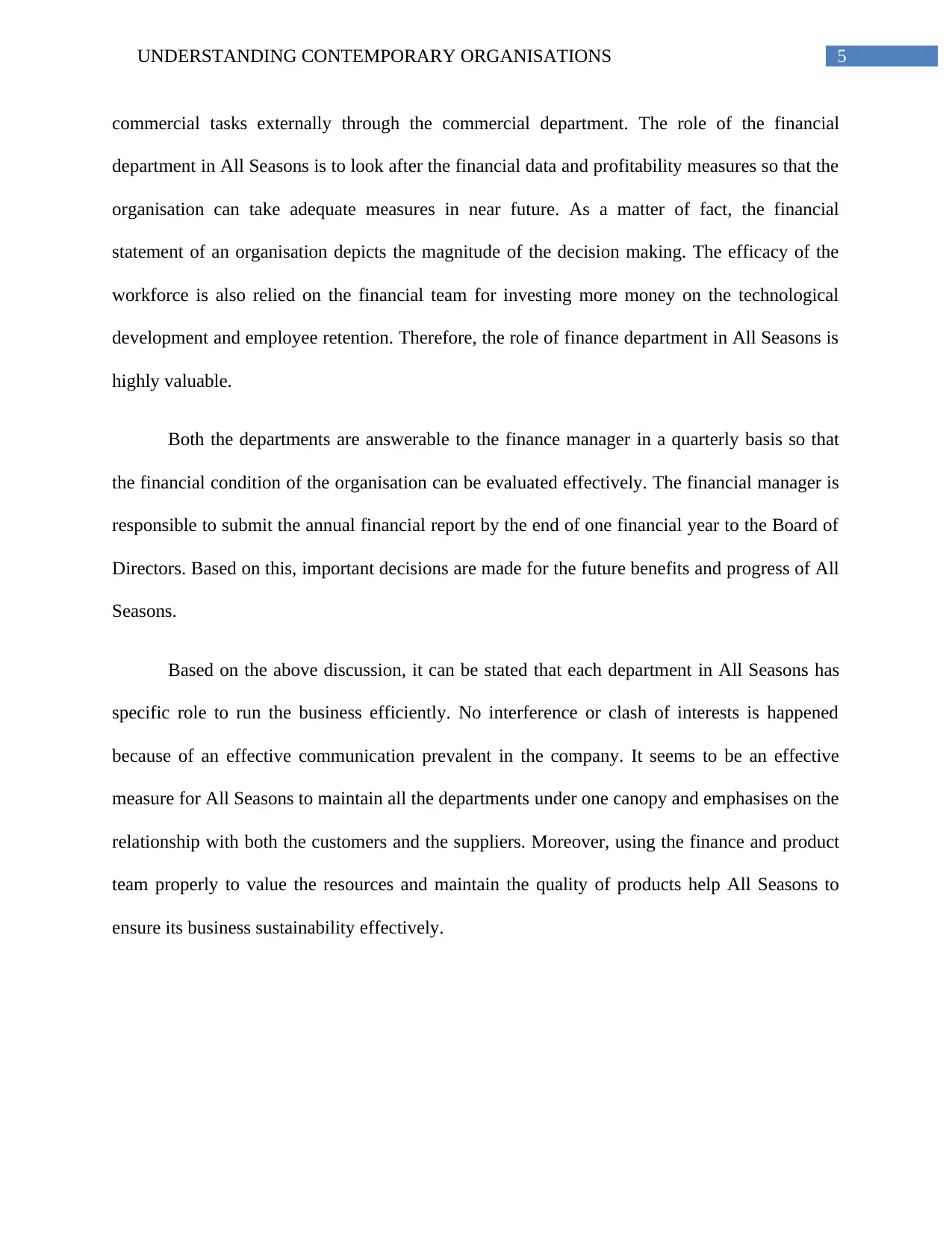
5UNDERSTANDING CONTEMPORARY ORGANISATIONS
commercial tasks externally through the commercial department. The role of the financial
department in All Seasons is to look after the financial data and profitability measures so that the
organisation can take adequate measures in near future. As a matter of fact, the financial
statement of an organisation depicts the magnitude of the decision making. The efficacy of the
workforce is also relied on the financial team for investing more money on the technological
development and employee retention. Therefore, the role of finance department in All Seasons is
highly valuable.
Both the departments are answerable to the finance manager in a quarterly basis so that
the financial condition of the organisation can be evaluated effectively. The financial manager is
responsible to submit the annual financial report by the end of one financial year to the Board of
Directors. Based on this, important decisions are made for the future benefits and progress of All
Seasons.
Based on the above discussion, it can be stated that each department in All Seasons has
specific role to run the business efficiently. No interference or clash of interests is happened
because of an effective communication prevalent in the company. It seems to be an effective
measure for All Seasons to maintain all the departments under one canopy and emphasises on the
relationship with both the customers and the suppliers. Moreover, using the finance and product
team properly to value the resources and maintain the quality of products help All Seasons to
ensure its business sustainability effectively.
commercial tasks externally through the commercial department. The role of the financial
department in All Seasons is to look after the financial data and profitability measures so that the
organisation can take adequate measures in near future. As a matter of fact, the financial
statement of an organisation depicts the magnitude of the decision making. The efficacy of the
workforce is also relied on the financial team for investing more money on the technological
development and employee retention. Therefore, the role of finance department in All Seasons is
highly valuable.
Both the departments are answerable to the finance manager in a quarterly basis so that
the financial condition of the organisation can be evaluated effectively. The financial manager is
responsible to submit the annual financial report by the end of one financial year to the Board of
Directors. Based on this, important decisions are made for the future benefits and progress of All
Seasons.
Based on the above discussion, it can be stated that each department in All Seasons has
specific role to run the business efficiently. No interference or clash of interests is happened
because of an effective communication prevalent in the company. It seems to be an effective
measure for All Seasons to maintain all the departments under one canopy and emphasises on the
relationship with both the customers and the suppliers. Moreover, using the finance and product
team properly to value the resources and maintain the quality of products help All Seasons to
ensure its business sustainability effectively.
⊘ This is a preview!⊘
Do you want full access?
Subscribe today to unlock all pages.

Trusted by 1+ million students worldwide
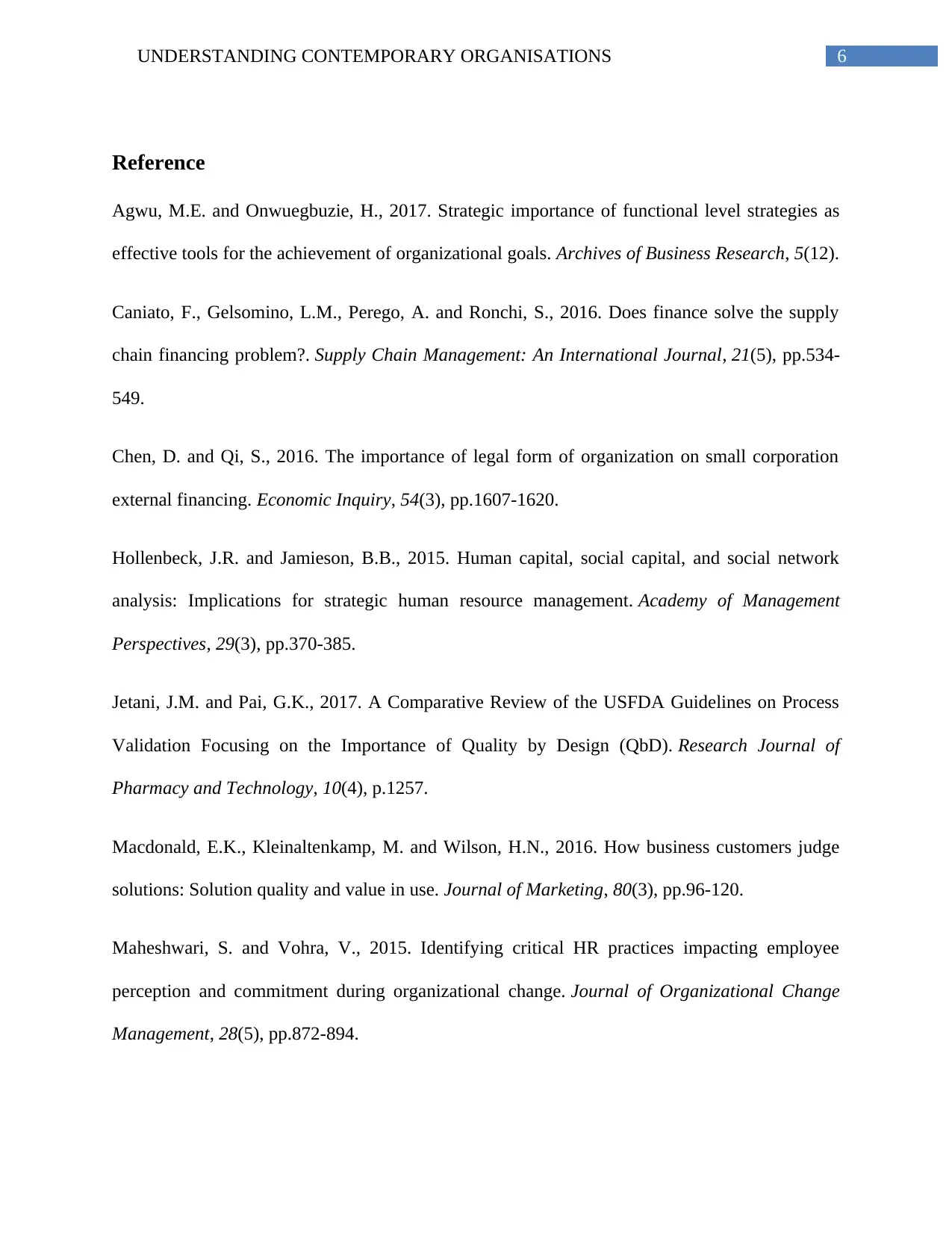
6UNDERSTANDING CONTEMPORARY ORGANISATIONS
Reference
Agwu, M.E. and Onwuegbuzie, H., 2017. Strategic importance of functional level strategies as
effective tools for the achievement of organizational goals. Archives of Business Research, 5(12).
Caniato, F., Gelsomino, L.M., Perego, A. and Ronchi, S., 2016. Does finance solve the supply
chain financing problem?. Supply Chain Management: An International Journal, 21(5), pp.534-
549.
Chen, D. and Qi, S., 2016. The importance of legal form of organization on small corporation
external financing. Economic Inquiry, 54(3), pp.1607-1620.
Hollenbeck, J.R. and Jamieson, B.B., 2015. Human capital, social capital, and social network
analysis: Implications for strategic human resource management. Academy of Management
Perspectives, 29(3), pp.370-385.
Jetani, J.M. and Pai, G.K., 2017. A Comparative Review of the USFDA Guidelines on Process
Validation Focusing on the Importance of Quality by Design (QbD). Research Journal of
Pharmacy and Technology, 10(4), p.1257.
Macdonald, E.K., Kleinaltenkamp, M. and Wilson, H.N., 2016. How business customers judge
solutions: Solution quality and value in use. Journal of Marketing, 80(3), pp.96-120.
Maheshwari, S. and Vohra, V., 2015. Identifying critical HR practices impacting employee
perception and commitment during organizational change. Journal of Organizational Change
Management, 28(5), pp.872-894.
Reference
Agwu, M.E. and Onwuegbuzie, H., 2017. Strategic importance of functional level strategies as
effective tools for the achievement of organizational goals. Archives of Business Research, 5(12).
Caniato, F., Gelsomino, L.M., Perego, A. and Ronchi, S., 2016. Does finance solve the supply
chain financing problem?. Supply Chain Management: An International Journal, 21(5), pp.534-
549.
Chen, D. and Qi, S., 2016. The importance of legal form of organization on small corporation
external financing. Economic Inquiry, 54(3), pp.1607-1620.
Hollenbeck, J.R. and Jamieson, B.B., 2015. Human capital, social capital, and social network
analysis: Implications for strategic human resource management. Academy of Management
Perspectives, 29(3), pp.370-385.
Jetani, J.M. and Pai, G.K., 2017. A Comparative Review of the USFDA Guidelines on Process
Validation Focusing on the Importance of Quality by Design (QbD). Research Journal of
Pharmacy and Technology, 10(4), p.1257.
Macdonald, E.K., Kleinaltenkamp, M. and Wilson, H.N., 2016. How business customers judge
solutions: Solution quality and value in use. Journal of Marketing, 80(3), pp.96-120.
Maheshwari, S. and Vohra, V., 2015. Identifying critical HR practices impacting employee
perception and commitment during organizational change. Journal of Organizational Change
Management, 28(5), pp.872-894.
Paraphrase This Document
Need a fresh take? Get an instant paraphrase of this document with our AI Paraphraser
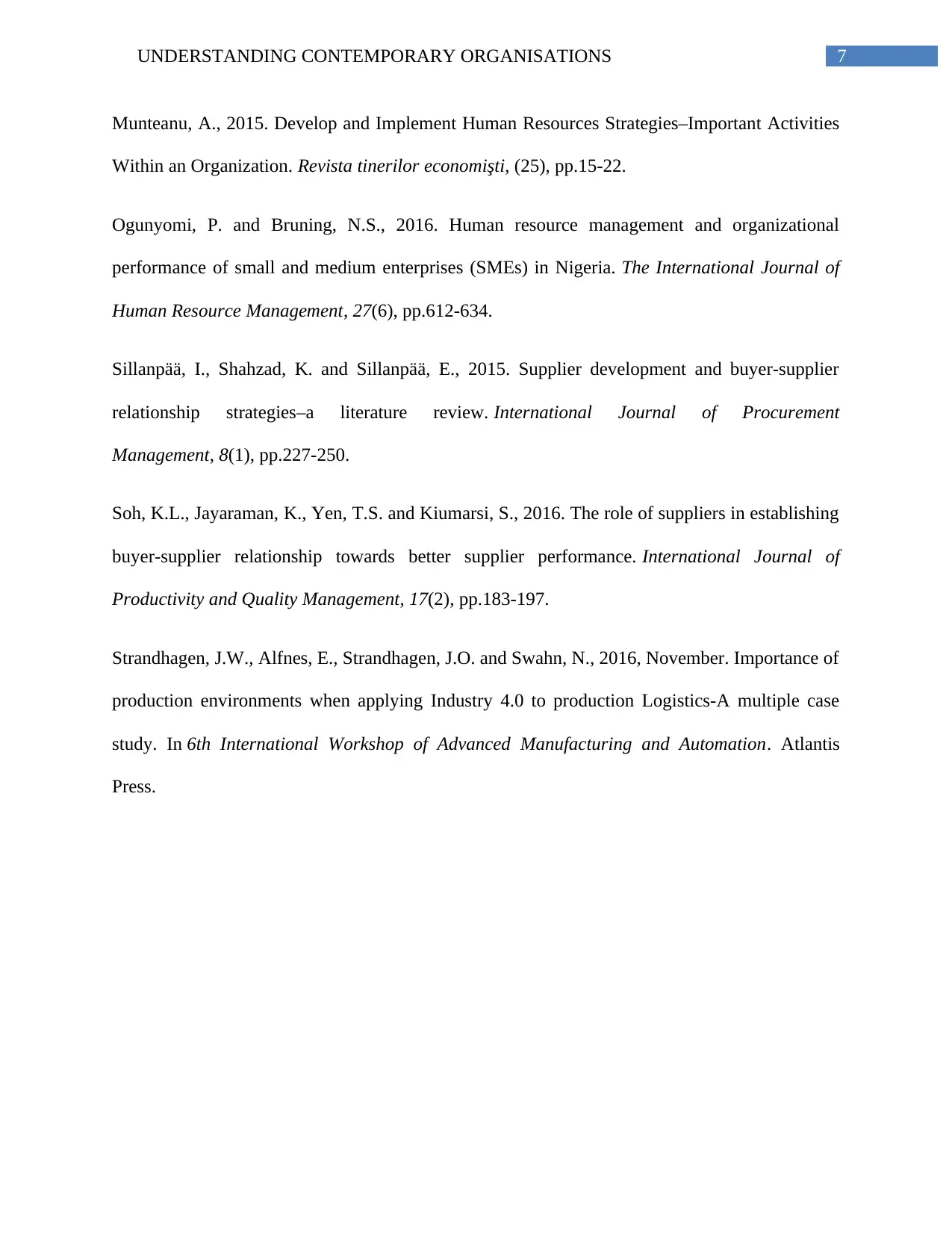
7UNDERSTANDING CONTEMPORARY ORGANISATIONS
Munteanu, A., 2015. Develop and Implement Human Resources Strategies–Important Activities
Within an Organization. Revista tinerilor economişti, (25), pp.15-22.
Ogunyomi, P. and Bruning, N.S., 2016. Human resource management and organizational
performance of small and medium enterprises (SMEs) in Nigeria. The International Journal of
Human Resource Management, 27(6), pp.612-634.
Sillanpää, I., Shahzad, K. and Sillanpää, E., 2015. Supplier development and buyer-supplier
relationship strategies–a literature review. International Journal of Procurement
Management, 8(1), pp.227-250.
Soh, K.L., Jayaraman, K., Yen, T.S. and Kiumarsi, S., 2016. The role of suppliers in establishing
buyer-supplier relationship towards better supplier performance. International Journal of
Productivity and Quality Management, 17(2), pp.183-197.
Strandhagen, J.W., Alfnes, E., Strandhagen, J.O. and Swahn, N., 2016, November. Importance of
production environments when applying Industry 4.0 to production Logistics-A multiple case
study. In 6th International Workshop of Advanced Manufacturing and Automation. Atlantis
Press.
Munteanu, A., 2015. Develop and Implement Human Resources Strategies–Important Activities
Within an Organization. Revista tinerilor economişti, (25), pp.15-22.
Ogunyomi, P. and Bruning, N.S., 2016. Human resource management and organizational
performance of small and medium enterprises (SMEs) in Nigeria. The International Journal of
Human Resource Management, 27(6), pp.612-634.
Sillanpää, I., Shahzad, K. and Sillanpää, E., 2015. Supplier development and buyer-supplier
relationship strategies–a literature review. International Journal of Procurement
Management, 8(1), pp.227-250.
Soh, K.L., Jayaraman, K., Yen, T.S. and Kiumarsi, S., 2016. The role of suppliers in establishing
buyer-supplier relationship towards better supplier performance. International Journal of
Productivity and Quality Management, 17(2), pp.183-197.
Strandhagen, J.W., Alfnes, E., Strandhagen, J.O. and Swahn, N., 2016, November. Importance of
production environments when applying Industry 4.0 to production Logistics-A multiple case
study. In 6th International Workshop of Advanced Manufacturing and Automation. Atlantis
Press.

8UNDERSTANDING CONTEMPORARY ORGANISATIONS
Managing Director
Factory manager
Marketing manager Production manager HR manager Finance manager
Senior merchandiser
Merchandiser
Junior merchandiser
Cutting manager Sewing room manager Finishing room manager
Employees Line supervisor Supervisor
Administrative staffs
Accounts manager Commercial manager
Appendices
Appendix 1
Figure 1: Organisational structure of All Seasons
(Created by the author)
Managing Director
Factory manager
Marketing manager Production manager HR manager Finance manager
Senior merchandiser
Merchandiser
Junior merchandiser
Cutting manager Sewing room manager Finishing room manager
Employees Line supervisor Supervisor
Administrative staffs
Accounts manager Commercial manager
Appendices
Appendix 1
Figure 1: Organisational structure of All Seasons
(Created by the author)
⊘ This is a preview!⊘
Do you want full access?
Subscribe today to unlock all pages.

Trusted by 1+ million students worldwide
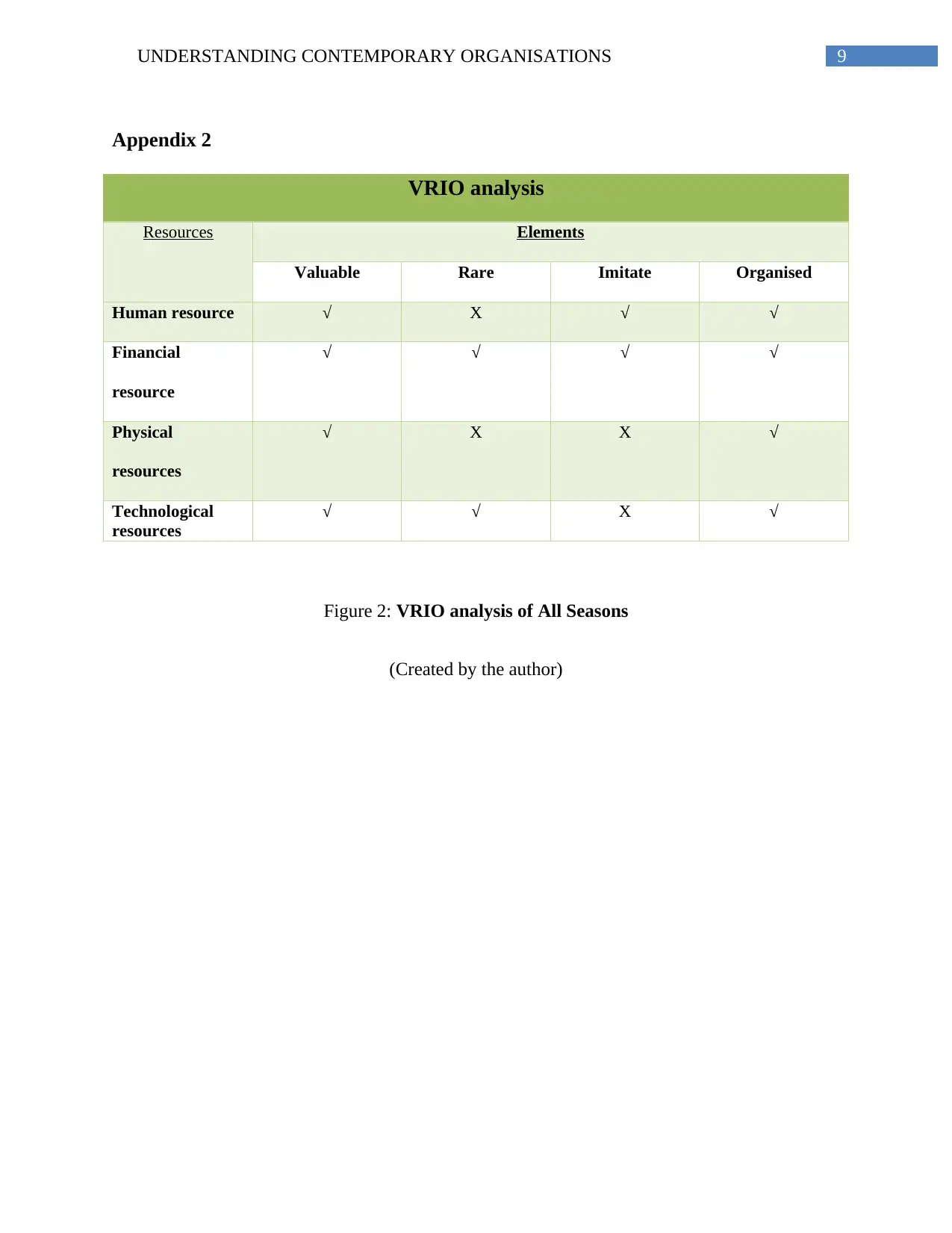
9UNDERSTANDING CONTEMPORARY ORGANISATIONS
Appendix 2
VRIO analysis
Resources Elements
Valuable Rare Imitate Organised
Human resource √ X √ √
Financial
resource
√ √ √ √
Physical
resources
√ X X √
Technological
resources
√ √ X √
Figure 2: VRIO analysis of All Seasons
(Created by the author)
Appendix 2
VRIO analysis
Resources Elements
Valuable Rare Imitate Organised
Human resource √ X √ √
Financial
resource
√ √ √ √
Physical
resources
√ X X √
Technological
resources
√ √ X √
Figure 2: VRIO analysis of All Seasons
(Created by the author)
1 out of 10
Related Documents
Your All-in-One AI-Powered Toolkit for Academic Success.
+13062052269
info@desklib.com
Available 24*7 on WhatsApp / Email
![[object Object]](/_next/static/media/star-bottom.7253800d.svg)
Unlock your academic potential
Copyright © 2020–2025 A2Z Services. All Rights Reserved. Developed and managed by ZUCOL.





